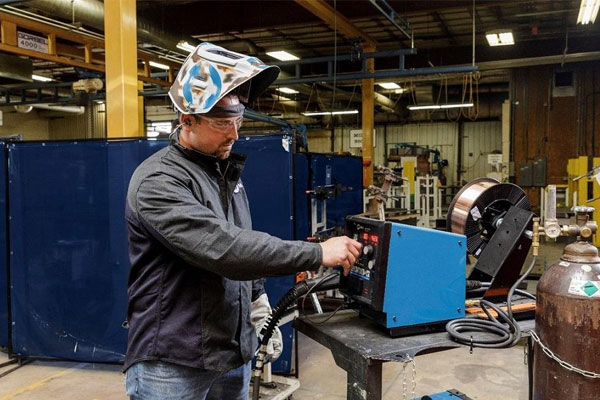
Flux-cored arc welding, also known as dual shield welding, is a semi-automatic arc welding, as known as dual shield welding that uses an arc between the consumable electrode and the weld pool.
FCAW is a versatile and efficient welding process widely used in construction and manufacturing. One key benefit of FCAW is its high deposition rate, which allows for faster welding speeds and increased productivity.
In the article below, let’s explore the history, machine setup, and workings of the flux-cored arc welding technique.
History
The flux-cored arc welding process was first developed in the 1950s. It was created to address the limitations of SMAW, such as low productivity and the need for frequent electrode changes.
The National Cylinder Gas Company introduced the process. It involved a continuous wire feed process, where the wire has a flux core that generates shielding gas and slag to protect the weld pool.
Significant advancements were made in the design and manufacturing of flux-cored wires during the 1960s, leading to better performance and usability.
By the 1980s, FCAW had become widely accepted in various industries, particularly in construction, shipbuilding, and heavy equipment manufacturing. Its ability to produce high-quality welds at a faster rate than Shielded metal arc welding (SMAW) made it popular for heavy-civil construction projects.
Flux Cored Arc Welding Machine Setup

Here is the complete machine setup of this welding technique.
1. Power Source Configuration

You have to connect the welding machine to an appropriate power source. Ensure the power source matches the machine’s requirements, typically 220V or 110V for smaller units. Also, check that the machine is properly grounded to prevent electrical hazards.
2. Wire Feed Setup

Now, you need to load the flux-cored wire spool into the wire feeder. Ensure the wire feeds smoothly through the guide tube and into the drive rolls. Adjust the tension on the drive rolls to match the wire diameter and type.
3. Welding Gun Preparation

Attach the welding gun to the machine. Insert the flux-cored wire through the gun liner until it extends slightly beyond the contact tip. Ensure the contact tip and nozzle are clean and appropriate for the wire size being used. Secure the gun’s connection to the wire feeder and power source.
4. Shielding Gas Connection

Some FCAW processes require shielding gas. Connect the gas cylinder to the machine using a regulator. Adjust the gas flow rate to the recommended setting, typically between 20-30 cubic feet per hour. Ensure there are no leaks in the gas lines.
5. Machine Parameters Setup

Set the machine parameters according to the welding requirements. This includes adjusting the voltage, wire feed speed, and polarity. For most dual shield welding processes, you can use direct current electrode negative polarity.
How Does Flux Cored Arc Welding Process Work?

The FCAW process begins with the welding machine feeding a flux-cored electrode through the welding gun and towards the workpiece. As the electrode makes contact with the base metal, an electric arc is struck between them.
The intense heat generated by the arc melts both the electrode and the base metal, forming a molten weld pool. The flux within the core of the electrode decomposes due to the heat, producing a shielding gas and slag.
The shielding gas protects the weld pool from atmospheric contaminants, while the slag covers the weld, preventing oxidation and ensuring a cleaner weld.
Things You Should Consider Before Using Flux Cored Arc Welding Process
Below, we have gathered a list of a few things to consider before using this welding technique.
- FCAW is not suitable for thin materials. It is often used for welding carbon steels, low-alloy steels, stainless steels, and some nickel alloys.
- Make sure that the workpiece is clean and free from contaminants like rust, oil, and paint.
- The welding parameters and techniques may need to be adjusted based on the position to ensure proper fusion and deposition.
- You have to choose the appropriate flux-cored electrode that matches your base metal and welding requirements.
- The power source should provide adequate voltage and amperage settings to achieve the desired weld quality and appearance.
- After welding, you have to clean the weld area to remove slag, spatter, and other contaminants. You have to inspect the weld for defects such as lack of fusion, porosity, or cracks.
Pros and Cons of Flux Cored Arc Welding Process
Pros | Cons |
Limited Material Types. |
What is Flux Cored Arc Welding Used For?
- Construction
- Fabrication
- Shipbuilding
- Pipeline Welding
- Automotive
Frequently Asked Questions
1. What are the types of FCAW?
There are two types of FCAW: self-shielded (FCAW-S) and gas-shielded (FCAW-G). Self-shielded does not require external gas, while gas-shielded uses an external shielding gas.
2. What materials can be welded with FCAW?
FCAW can weld a variety of materials, including carbon steel, stainless steel, and some nickel alloys.
3. What are the advantages of FCAW?
Advantages include high welding speed, good penetration, and the ability to weld thicker materials.
4. What equipment is needed for FCAW?
Equipment includes a welding machine, a wire feeder, a flux-cored welding wire, and sometimes an external shielding gas supply for FCAW-G.
5. What are the common applications of FCAW?
Common applications include heavy equipment repair, construction, shipbuilding, and pipeline welding.
Wrapping Up
Flux cored arc welding or dual shield welding is a vital welding technique in industries where efficiency, versatility, and cost-effectiveness are paramount. By mastering FCAW, welders can achieve high productivity and quality welds, meeting the demanding requirements of modern manufacturing and construction.







